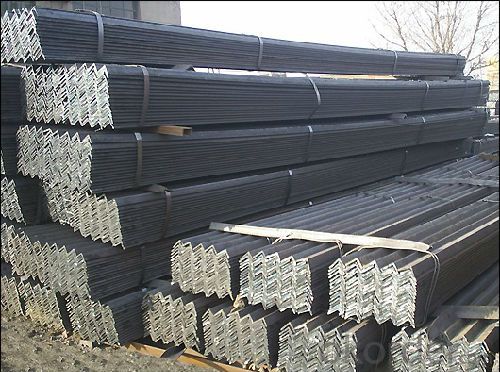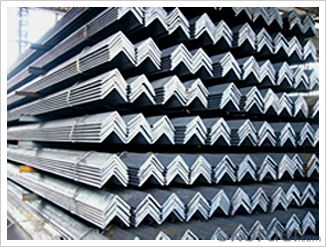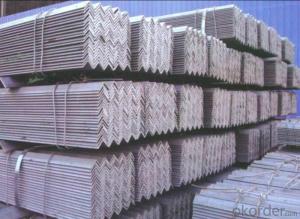HOT ROLLED SHEET EQUAL ANGLE for construction GB Q235B
- Loading Port:
- Tianjin
- Payment Terms:
- TT or LC
- Min Order Qty:
- 25 m.t.
- Supply Capability:
- 100000 m.t./month
OKorder Service Pledge
OKorder Financial Service
You Might Also Like
Product Description:
OKorder is offering hot rolled sheet equal angle for construction GB Q235Bat great prices with worldwide shipping. Our supplier is a world-class manufacturer of steel, with our products utilized the world over. OKorder annually supplies products to European, North American and Asian markets. We provide quotations within 24 hours of receiving an inquiry and guarantee competitive prices.
Product Applications:
Hot rolled sheet equal angle are ideal for structural applications and are widely used in the construction of buildings and bridges, and the manufacturing, petrochemical, and transportation industries.
Product Advantages:
OKorder's sheet equal angle are durable, strong, and resist corrosion.
Main Product Features:
· Premium quality
· Prompt delivery & seaworthy packing (30 days after receiving deposit)
· Corrosion resistance
· Can be recycled and reused
· Mill test certification
· Professional Service
· Competitive pricing
Product Specifications:
1.Standards:GB,ASTM,BS,AISI,DIN,JIS
2.Invoicing on theoretical weight or actual weight as customer request
3.Material: JIS G3192,SS400;SS540.
4. Payment terms:
1).100% irrevocable L/C at sight.
2).30% T/T prepaid and the balance against the copy of B/L.
3).30% T/T prepaid and the balance against L/C
5.Sizes:

EQUAL ANGLES SIZES |
| ||
a(mm) | a1(mm) | thickness(mm) | length |
25 | 25 | 2.5---3.0 | 6M/12M |
30 | 30 | 2.5---4.0 | 6M/12M |
38 | 38 | 2.5 | 6M/12M |
38 | 38 | 3.0---5.0 | 6M/12M |
40 | 40 | 3.0---6.0 | 6M/12M |
50 | 50 | 3 | 6M/12M |
50 | 50 | 3.7---6.0 | 6M/9M/12M |
60 | 60 | 5.0---6.0 | 6M/9M/12M |
63 | 63 | 6.0---8.0 | 6M/9M/12M |
65 | 65 | 5.0---8.0 | 6M/9M/12M |
70 | 70 | 6.0---7.0 | 6M/9M/12M |
75 | 75 | 5.0---10.0 | 6M/9M/12M |
80 | 80 | 6.0---10.0 | 6M/9M/12M |
90 | 90 | 6.0---10.0 | 6M/9M/12M |
100 | 100 | 6.0---12.0 | 6M/9M/12M |
120 | 120 | 8.0-12.0 | 6M/9M/12M |
125 | 125 | 8.0---12.0 | 6M/9M/12M |
130 | 130 | 9.0-12.0 | 6M/9M/12M |
140 | 140 | 10.0-16.0 | 6M/9M/12M |
150 | 150 | 10---15 | 6M/9M/12M |
160 | 160 | 10---16 | 6M/9M/12M |
180 | 180 | 12---18 | 6M/9M/12M |
200 | 200 | 14---20 | 6M/9M/12M |
5. Material Specifications:
Grade | Yield Strength,N/mm² | Extension Strength N/mm² | |||
Thickness of Steel,mm | |||||
≦16 | >16-≦40 | >40-≦100 | >100 | ||
SS330 | ≧205 | ≧195 | ≧175 | ≧165 | 330-430 |
SS400 | ≧245 | ≧235 | ≧215 | ≧205 | 400-510 |
SS490 | ≧285 | ≧275 | ≧255 | ≧245 | 490-610 |
SS540 | ≧400 | ≧390 | - | - | ≧540 |
FAQ:
Q1: What makes stainless steel stainless?
A1: Stainless steel must contain at least 10.5 % chromium. It is this element that reacts with the oxygen in the air to form a complex chrome-oxide surface layer that is invisible but strong enough to prevent further oxygen from "staining" (rusting) the surface. Higher levels of chromium and the addition of other alloying elements such as nickel and molybdenum enhance this surface layer and improve the corrosion resistance of the stainless material.
Q2: Why buy Materials & Equipment from OKorder.com?
A2: All products offered byOKorder.com are carefully selected from China's most reliable manufacturing enterprises. Through its ISO certifications, OKorder.com adheres to the highest standards and a commitment to supply chain safety and customer satisfaction.
Images:



- Q:Can steel angles be cold-formed or bent to specific shapes?
- Indeed, it is possible to cold-form or bend steel angles to attain particular shapes. Cold forming refers to the act of reshaping metal without the application of heat, usually accomplished through techniques such as bending, rolling, or pressing. Steel angles, which consist of L-shaped steel components, can undergo cold forming to achieve diverse shapes and angles in accordance with project specifications. This procedure entails exerting force and pressure on the steel angle, resulting in its deformation and acquisition of the desired form. By employing cold forming techniques on steel angles, one can achieve design flexibility and customization while preserving the strength and durability of the steel material.
- Q:How do steel angles contribute to the overall torsional stiffness of a structure?
- Steel angles can contribute to the overall torsional stiffness of a structure in several ways. Firstly, steel angles have a high moment of inertia, which means they are resistant to bending. This resistance to bending helps to distribute and resist the torsional forces acting on the structure, reducing any twisting or warping that may occur. Secondly, steel angles can be strategically placed and connected in a structure to form bracing or reinforcement systems. These systems help to transfer and distribute torsional forces throughout the structure, preventing localized areas from experiencing excessive twisting or distortion. Furthermore, steel angles can be used to create rigid connections between different structural members, such as beams or columns. These connections enhance the overall stiffness of the structure by effectively transmitting torsional forces between the connected members, minimizing any relative movement or deformation. Moreover, steel angles can also be utilized as diagonal members in truss structures or frames. By introducing diagonals, the angles help to resist and distribute torsional forces, maintaining the overall stability and rigidity of the structure. Overall, steel angles play a crucial role in enhancing the torsional stiffness of a structure by providing resistance to bending, forming bracing or reinforcement systems, creating rigid connections, and acting as diagonal members. By effectively managing and distributing torsional forces, steel angles contribute to the overall stability, durability, and performance of the structure.
- Q:How do you determine the required number of steel angles for a project?
- Determining the necessary quantity of steel angles for a project involves taking into account several factors. First and foremost, it is crucial to comprehend the project's design and specifications. This encompasses the structural prerequisites, load-bearing capacities, and any specific angles or dimensions that must be incorporated. Subsequently, the dimensions of the steel angles need to be ascertained based on the intended utilization and structural prerequisites. This entails considering the suitable length, width, and thickness of the angles for the project. Once the dimensions are established, the subsequent step involves calculating the requisite number of angles. This can be accomplished by meticulously measuring and estimating the lengths of the steel angles required in each area of the project. It is important to take into account any potential waste or additional cuts that might be necessary during the installation process. Furthermore, it is advisable to seek advice from structural engineers or professionals well-versed in steel fabrication to ensure precise calculations and to confirm that the chosen steel angles fulfill the necessary safety standards and building codes. Ultimately, determining the necessary quantity of steel angles for a project necessitates a combination of meticulous planning, accurate measurements, and professional expertise to guarantee that the project is structurally sound and meets all the necessary requirements.
- Q:Can steel angles be used for reinforcement bars?
- No, steel angles cannot be used as reinforcement bars. While both steel angles and reinforcement bars are made of steel, they have different structural properties and purposes. Reinforcement bars, also known as rebar, are specifically designed to provide tensile strength and reinforcement to concrete structures. They have a ribbed or deformed surface to improve bonding with the concrete. On the other hand, steel angles are L-shaped structural components primarily used for providing support and stability in construction projects. They are not suitable for providing the necessary tensile strength and bonding required for reinforcement in concrete structures. Therefore, it is important to use the appropriate materials for their intended purposes to ensure the structural integrity and safety of the construction project.
- Q:Can steel angles be used in conveyor systems?
- Yes, steel angles can be used in conveyor systems. Steel angles are commonly used in conveyor systems to provide structural support and stability. They can be utilized to create the framework for the conveyor system, including the conveyor bed, side frames, and supports. Steel angles are known for their strength and durability, making them an ideal material for handling heavy loads and withstanding the continuous movement and impact that conveyor systems experience. Additionally, steel angles can be easily welded or bolted together, allowing for flexibility in designing and customizing conveyor systems to meet specific requirements. Overall, steel angles are a popular choice in conveyor system construction due to their reliability, versatility, and cost-effectiveness.
- Q:Can steel angles be used as framing members in buildings?
- Yes, steel angles can be used as framing members in buildings. Steel angles are commonly used in structural applications due to their strength, durability, and versatility. They provide excellent support and stability, making them suitable for framing various building elements such as walls, floors, and roofs.
- Q:Can steel angles be used for staircases?
- Yes, steel angles can be used for staircases. Steel angles are commonly used as structural supports in construction, including for staircases. They provide strength and stability to the staircase structure and can be designed to meet specific load-bearing requirements.
- Q:How do steel angles compare to other structural shapes?
- Steel angles are a versatile and commonly used structural shape in construction and engineering, offering several advantages over beams or channels. To begin with, their L-shaped design provides excellent strength and stability, making them ideal for load-bearing applications. They can effectively resist both compressive and tensile forces, making them suitable for a wide range of structural uses. Furthermore, steel angles have a compact and space-saving profile, making them more efficient in terms of material usage compared to beams or channels. This can result in cost savings and reduced weight in construction projects. Moreover, steel angles can be easily customized to fit specific project requirements. They can be cut, welded, drilled, and modified without compromising their structural integrity, allowing for easy integration into various structural systems. Additionally, steel angles offer versatile connection options. They can be bolted, welded, or riveted, providing flexibility in joining them with other structural components, making them suitable for a wide range of building and construction projects. Lastly, steel angles are readily available and cost-effective. They are widely produced and stocked by steel manufacturers, making them easily accessible. Their affordability, combined with their durability and strength, makes them a popular choice for structural applications. In summary, steel angles excel in strength, space-saving design, adaptability, connection options, and cost-effectiveness compared to other structural shapes. Their versatility and performance make them a preferred choice in various construction and engineering projects.
- Q:What is angle flower? Is it the same as angle iron?
- I'm here to tell you that the angle iron is the common name of galvanized steel bar, so the difference between the angle iron and the angle iron is that the surface is made of zinc coating. Angle iron is generally used for electrical installations.
- Q:Are steel angles suitable for architectural applications?
- Yes, steel angles are suitable for architectural applications. They are commonly used in construction projects to provide structural support, such as in building frames, facades, and bridges. Steel angles offer excellent strength and durability, making them a reliable choice for architects seeking a versatile and long-lasting material for their designs.
1. Manufacturer Overview |
|
|---|---|
| Location | |
| Year Established | |
| Annual Output Value | |
| Main Markets | |
| Company Certifications | |
2. Manufacturer Certificates |
|
|---|---|
| a) Certification Name | |
| Range | |
| Reference | |
| Validity Period | |
3. Manufacturer Capability |
|
|---|---|
| a)Trade Capacity | |
| Nearest Port | |
| Export Percentage | |
| No.of Employees in Trade Department | |
| Language Spoken: | |
| b)Factory Information | |
| Factory Size: | |
| No. of Production Lines | |
| Contract Manufacturing | |
| Product Price Range | |
Send your message to us
HOT ROLLED SHEET EQUAL ANGLE for construction GB Q235B
- Loading Port:
- Tianjin
- Payment Terms:
- TT or LC
- Min Order Qty:
- 25 m.t.
- Supply Capability:
- 100000 m.t./month
OKorder Service Pledge
OKorder Financial Service
Similar products
New products
Hot products
Related keywords



























